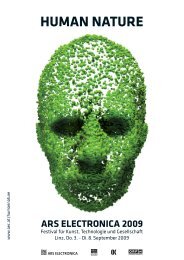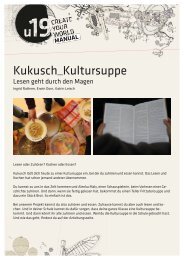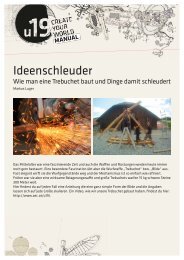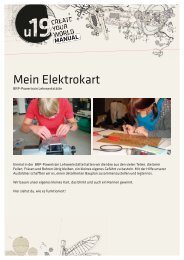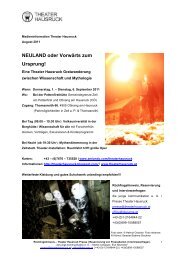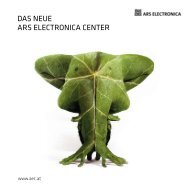festival - Ars Electronica Center
festival - Ars Electronica Center
festival - Ars Electronica Center
Sie wollen auch ein ePaper? Erhöhen Sie die Reichweite Ihrer Titel.
YUMPU macht aus Druck-PDFs automatisch weboptimierte ePaper, die Google liebt.
48<br />
EXHIBITIONS EXHIBITIONS<br />
ABC-Showcase<br />
<strong>Ars</strong> electronica <strong>Center</strong><br />
Der ABC-Showcase, in dem sich alles um Buchstaben dreht, ist Ausstellungsraum,<br />
Experimentierstation und Inspirationsquelle zugleich (siehe<br />
Seite 10).<br />
The ABC Showcase is all about letters—an exhibition space, a setting for<br />
experimentation and a source of inspiration all in one (see page 10).<br />
Photo: AEC, Martin Hieslmair<br />
Fifty Sisters<br />
Jon McCormack (AU)<br />
<strong>Ars</strong> electronica <strong>Center</strong>, foyer<br />
Fifty Sisters ist eine Arbeit des australischen Medienkünstlers Jon<br />
McCormack, die während eines Aufenthalts als Artist-in-Residence im<br />
<strong>Ars</strong> <strong>Electronica</strong> Futurelab entstanden ist. Sie besteht aus 50 je einen<br />
Quadratmeter großen Drucken mit Pflanzen, die McCormack am Computer<br />
erschaffen hat. Die Formen der digital mutierten Gewächse leiten sich von<br />
den Logos sieben großer Ölkonzerne her, die das Ölgeschäft als “Seven<br />
Sisters”-Kartell bis zur Energiekrise in den 1970ern beherrschten. In ihrer<br />
Struktur beziehen sich McCormacks Schöpfungen auch auf die Pflanzenwelt<br />
des Mesozoikums, die in die gegenwärtig ausgebeuteten Erdölvorkommen<br />
aufgegangen ist. So schafft Fifty Sisters verschiedene Bezüge:<br />
zur Ölabhängigkeit der Weltwirtschaft, zur Durchdringung unseres Alltags<br />
mit Erdölprodukten wie Plastik, zum natürlichen Rohstoff Erdöl sowie zur<br />
massiven Naturzerstörung durch Ölförderung und Ölunfälle.<br />
Australian media artist Jon McCormack<br />
created “Fifty Sisters” during his stint as<br />
artist-in-residence at the <strong>Ars</strong> <strong>Electronica</strong><br />
Futurelab. It consists of 50 one-squaremeter<br />
prints with plants that McCormack<br />
produced on the computer. The forms of<br />
the digitally mutated plants are the logos<br />
of the seven large oil companies that, as<br />
the “Seven Sisters” cartel, controlled the<br />
oil industry until the energy crisis of the<br />
1970s. McCormack derived the structures<br />
of his creations from the flora of the<br />
Mesozoic Age, the geologic period when<br />
oil deposits began to accumulate. “Fifty<br />
Sisters” thus uses multiple allusions: to<br />
the world economy’s dependency on oil,<br />
to the all-pervasiveness in everyday life<br />
of oil-based products like plastic, to the<br />
natural resource petroleum, and to environmental<br />
destruction on a massive scale<br />
caused by drilling and transporting oil.<br />
Developed in collaboration with the <strong>Ars</strong><br />
<strong>Electronica</strong> Future Lab and with support<br />
from Monash University. The Australian<br />
Artist-in-Residence program at the<br />
FutureLab was initiated and produced<br />
by Novamedia in partnership with the<br />
Australia Council for the Arts and <strong>Ars</strong><br />
<strong>Electronica</strong>.<br />
Hugvie<br />
Photo: Jon McCormack<br />
Advanced Telecommunications Research Institute International (JP)<br />
<strong>Ars</strong> electronica <strong>Center</strong><br />
Hugvie macht aus dem Ferngespräch mit einem nahestehenden<br />
Menschen ein Nahgespräch. Beim Telefonieren vermittelt der weich<br />
umhüllte kissenförmige Roboter ein starkes körperliches Gefühl der<br />
unmittelbaren und im wahrsten Sinn leibhaftigen Präsenz des anderen.<br />
Mit einer sanften Vibration erzeugt Hugvie das Gefühl, den Herzschlag<br />
des (Gesprächs-)Partners zu spüren. Damit gleicht diese epochale und<br />
erschwingliche Erfindung eines der großen Mankos der Telekommunikation<br />
aus – das Manko der Distanz, das von allen beklagt wird, die sich<br />
von fern nacheinander sehnen. Der aus dem englischen hug = umarmen<br />
und dem französischen vie = Leben zusammengesetzte Name<br />
verdeutlicht den Stellenwert der außer durch den kleinen japanischen<br />
Roboter durch nichts zu ersetzenden körperlichen Nähe für jede tiefe<br />
menschliche Beziehung.<br />
“Hugvie” turns a long-distance call<br />
with someone you’re close to into a<br />
very local call. When you’re on the<br />
phone, the cuddly, pillow-shaped robot<br />
gets across an intensely physical feeling<br />
of the immediate and, in the truest<br />
sense of the word, corporeal presence<br />
of the other person. With a gentle<br />
vibration, Hugvie imparts the sensation<br />
of being able to feel the heartbeat<br />
of the person you’re talking to. This<br />
enormously significant and easily affordable<br />
invention thus compensates<br />
for what is perhaps telecommunication’s<br />
greatest shortcoming—the<br />
distance bemoaned by all who long<br />
for another from afar. The name—a<br />
portmanteau of the English word hug<br />
and the French word for life—makes<br />
clear how, for a deep human relationship, there’s no substitute for physical<br />
intimacy (except this tiny Japanese robot).<br />
Brain Painting<br />
Adi Hoesle (DE), Andrea Kübler (DE), Lars Schwabe (DE)<br />
<strong>Ars</strong> electronica <strong>Center</strong><br />
Brain Sculpturing Sessions<br />
Fr/Fri 31. 8. 14:30<br />
Mo/Mon 3. 9. 16:00<br />
<strong>Ars</strong> electronica <strong>Center</strong>, deep Space<br />
Am Computer Bilder zu malen, ohne dabei die Hände, Tastatur oder<br />
Maus einzusetzen: Brain Painting macht es durch ein Brain-Computer-<br />
Interface (BCI) und spezielle Software möglich. Brain Painting-Kunstwerke<br />
entstehen durch bewusste Gehirnaktivität. Gehirnströme werden dabei in<br />
Bilder umgesetzt. Im Prinzip heißt das: Malen durch Denken. Das eröffnet<br />
beispielsweise vollkommen gelähmten Menschen bisher unvorstellbare<br />
Möglichkeiten, sich auszudrücken. Dahinter steckt ein psychologischer<br />
Forschungsansatz der Universität Würzburg, dem der Künstler Adi Hoesle<br />
(DE) nachgegangen ist: Welche Hirnaktivitäten oder neuronalen Muster<br />
eignen sich, um Kunst zu schaffen?<br />
Paint pictures at a computer without the use of your hands, keyboard or<br />
mouse. Brain Painting lets you produce images with the conscious activity<br />
of your brainwaves, which a brain-computer interface (BCI) and special<br />
software translate into actual pictures. The principle is: painting by thinking.<br />
And this opens up previously unimaginable expressive possibilities—for<br />
example, for paraplegics. What’s behind it is a psychological research approach<br />
in use at the University of Würzburg, which artist Adi Hoesle (DE) has<br />
been investigating to find out which brainwaves or neuronal patterns are<br />
best suited to creating art.<br />
Photo: AEC, Erika Jungreithmayr<br />
Inside Futurelab<br />
<strong>Ars</strong> electronica <strong>Center</strong>, Infodeck<br />
Die Schau am Infodeck gewährt Einblicke in laufende und bereits realisierte<br />
Projekte des <strong>Ars</strong> <strong>Electronica</strong>. Die einzelnen vorgestellten Arbeiten sind<br />
Stellvertreter für die formale und inhaltliche Vielfalt der im Futurelab<br />
umgesetzten Vorhaben. Sie verdeutlichen, dass transdisziplinäre Zusammenarbeit<br />
im Futurelab eine täglich ge- und erlebte Realität ist, die<br />
weit über die Zusammenschau einiger weniger künstlerischer Disziplinen<br />
hinausgeht. Neben Projekten wie ZeitRaum, St(Age) of Participation und<br />
Fingermarathon zeigt die Ausstellung auch Arbeiten, die im Kontext der<br />
Futurelab.Academy an der China Academy of Art entstanden sind.<br />
The show on the Infodeck gives visitors a glimpse at what Futurelab staffers<br />
are currently at work on or have recently completed. The individual projects<br />
being presented can be considered as proxies representative of the formal<br />
and substantive diversity of the Futurelab’s work. They make it clear that<br />
transdisciplinary collaboration is a reality lived out and experienced on a daily<br />
basis at the Futurelab, and that this goes way beyond just sampling a few<br />
artistic disciplines. In addition to ZeitRaum [TimeSpace], St(Age) of Participation<br />
and Fingermarathon, the exhibition will include works produced in<br />
the context of the Futurelab.Academy at the China Academy of Art.<br />
49



